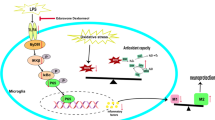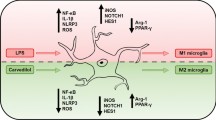Abstract
Microglia are the inherent immune effector cells in the central nervous system (CNS), are activated rapidly when the CNS is stimulated by ischaemia, infection, injury, etc. and participate in and aggravate the development of inflammatory reactions in the CNS. During the process of microglial activation, inflammatory factors such as TNF-α and IL-1β and an abundance of reactive oxygen species (ROS)/reactive nitrogen species (RNS), are released by damaged nerve cells. LXW7 is a small molecule peptide and specifically binds with integrin αvβ3. Cerium oxide nanoparticles (nanoceria) are strong free radical scavengers and are widely used in many studies. In this research, a model of inflammation was established using lipopolysaccharide (LPS) to induce BV2 microglia activation, and the effects of CeO2@PAA (synthetic nanoscale cerium oxide particles), LXW7 and CeO2@PAA-LXW7 were evaluated. We detected the expression level of inflammatory factors, the release of NO in BV2 cells and the generation of intracellular ROS. The expression levels of focal adhesion kinase (FAK) and signal transducer and activator of transcription 3 (STAT3) and their phosphorylated proteins were detected in BV2 microglia. We found that CeO2@PAA, LXW7 and CeO2@PAA-LXW7 all effectively inhibited the activation of BV2 microglia, reduced the production of cytokines and the release of NO and reduced the production of intracellular ROS. The three treatments all inhibited the phosphorylation of FAK and STAT3 in BV2 microglia. Regarding these effects, CeO2@PAA-LXW7 was more effective than the other two monotherapies. Our data indicate that CeO2@PAA, LXW7 and CeO2@PAA-LXW7 can exert a neuroprotective function by inhibiting the inflammatory response of LPS-induced BV2 microglia. LXW7 may inhibit the activation of FAK and STAT3 signals in combination with integrin αvβ3 to restrain neuroinflammation and the antioxidative stress effect of cerium oxide; hence, CeO2@PAA-LXW7 can exert a more robust anti-inflammatory and neuroprotective effect via synergistically suppressing the ability of LXW7 to influence the integrin pathway and the free radical-scavenging ability of CeO2@PAA.







Similar content being viewed by others
References
Amantea D, Certo M, Russo R, Bagetta G, Corasaniti MT, Tassorelli C (2014) Early reperfusion injury is associated to MMP2 and IL-1β elevation in cortical neurons of rats subjected to middle cerebral artery occlusion. Neuroscience 277:755
Becchetti A, Arcangeli A (2010) Integrins and ion channels in cell migration: implications for neuronal development, wound healing and metastatic spread. Adv Exp Med Biol 674:107
Cabodi S et al (1999) Integrins and signal transduction. Curr Opin Hematol 6:37
Celardo I, Nicola MD, Mandoli C, Pedersen JZ, Traversa E, Ghibelli L (2011) Ce3+ ions determine redox-dependent anti-apoptotic effect of cerium oxide nanoparticles. ACS Nano 5:4537–4549
Chan CS, Weeber EJ, Kurup S, Sweatt JD, Davis RL (2003) Integrin requirement for hippocampal synaptic plasticity and spatial memory. J Neurosci 23:7107–7116 The Official Journal of the Society for Neuroscience
Chan CS, Weeber EJ, Zong L, Fuchs E, Sweatt JD, Davis RL (2006) β1-Integrins are required for hippocampal AMPA receptor-dependent synaptic transmission, synaptic plasticity, and working memory. J Neurosci 26:223 The Official Journal of the Society for Neuroscience
Chen HC, Guan JL (1996) The association of focal adhesion kinase with a 200-kDa protein that is tyrosine phosphorylated in response to platelet-derived growth factor. FEBS J 235:495–500
Chen WT, Shih TT, Chen RC, Tu SY, Hsieh WY, Yang PC (2012) Integrin αvβ3-targeted dynamic contrast-enhanced magnetic resonance imaging using a gadolinium-loaded polyethylene gycol-dendrimer-cyclic RGD conjugate to evaluate tumor angiogenesis and to assess early antiangiogenic treatment response in a mouse xenogr. Mol Imaging 11:286
Clark A, Zhu A, Sun K, Petty HR (2011) Cerium oxide and platinum nanoparticles protect cells from oxidant-mediated apoptosis. J Nanoparticle Res 13:5547–5555. https://doi.org/10.1007/s11051-011-0544-3
Diao Y et al (2012) Designed synthetic analogs of the α-helical peptide temporin-La with improved antitumor efficacies via charge modification and incorporation of the integrin αvβ3 homing domain. J Pept Sci 18:476–486 An Official Publication of the European Peptide Society
Dinapoli VA et al (2010) Age exaggerates proinflammatory cytokine signaling and truncates signal transducers and activators of transcription 3 signaling following ischemic stroke in the rat. Neuroscience 170:633–644
Esch F et al (2005) Chemistry: electron localization determines defect formation on ceria substrates. Science 309:752
Estevez AY et al (2011) Neuroprotective mechanisms of cerium oxide nanoparticles in a mouse hippocampal brain slice model of ischemia. Free Radic Biol Med 51:1155–1163. https://doi.org/10.1016/j.freeradbiomed.2011.06.006
Fang T, Zhou D, Lu L, Tong X, Wu J, Yi L (2016) LXW7 ameliorates focal cerebral ischemia injury and attenuates inflammatory responses in activated microglia in rats. Braz J Med Biol Res 49:e5287. https://doi.org/10.1590/1414-431X20165287
Gao Y et al (2015) Enhanced antitumor efficacy by cyclic RGDyK-conjugated and paclitaxel-loaded pH-responsive polymeric micelles. Acta Biomater 23:127–135
Goodman SL, Picard M (2012) Integrins as therapeutic targets. Trends Pharmacol Sci 33:405–412. https://doi.org/10.1016/j.tips.2012.04.002
Hao D et al (2017) Discovery and characterization of a potent and specific peptide ligand targeting endothelial progenitor cells and endothelial cells for tissue regeneration. ACS Chem Biol 12:1075–1086. https://doi.org/10.1021/acschembio.7b00118
Haubner R, Gratias R, Diefenbach B, Goodman SL, Jonczyk A, Kessler H (1996) Structural and functional aspects of RGD-containing cyclic pentapeptides as highly potent and selective integrin αvβ3 antagonists. J Am Chem Soc 118(32):7461–7472
Huang C, Ma R, Sun S, Wei G, Fang Y, Liu R, Li G (2008) JAK2-STAT3 signaling pathway mediates thrombin-induced proinflammatory actions of microglia in vitro. J Neuroimmunol 204:118
Hynes RO (2002) Integrins: bidirectional, allosteric signaling machines. Cell 110:673
Jeon CM et al (2014) Siegesbeckia glabrescens attenuates allergic airway inflammation in LPS-stimulated RAW 264.7 cells and OVA induced asthma murine model. Int Immunopharmacol 22:414
Jia J et al (2018) Neuroprotective effect of CeO2 @PAA-LXW7 against H2O2-induced cytotoxicity in NGF-differentiated PC12 cells. Neurochem Res 43:1–15
Jin YC et al (2015) Intranasal delivery of RGD motif-containing osteopontin icosamer confers neuroprotection in the postischemic brain via α v β 3 integrin binding. Mol Neurobiol 53(8):5652–5663
Justicia C, Gabriel C, Planas AM (2000) Activation of the JAK/STAT pathway following transient focal cerebral ischemia: signaling through Jak1 and Stat3 in astrocytes. Glia 30:253–270
Kerrisk ME, Koleske AJ (2013) Arg kinase signaling in dendrite and synapse stabilization pathways: memory, cocaine sensitivity, and stress. Int J Biochem Cell Biol 45:2496–2500. https://doi.org/10.1016/j.biocel.2013.07.018
Krady JK, Basu A, Levison SW, Milner RJ (2002) Differential expression of protein tyrosine kinase genes during microglial activation. Glia 40:11
Kramar EA, Bernard JA, Gall CM, Lynch G (2003) Integrins modulate fast excitatory transmission at hippocampal synapses. J Biol Chem 278:10722–10730. https://doi.org/10.1074/jbc.M210225200
Li C et al (2014) Cytotoxicity of ultrafine monodispersed nanoceria on human gastric cancer cells. J Biomed Nanotechnol 10:1231
Liddelow SA et al (2017) Neurotoxic reactive astrocytes are induced by activated microglia. Nature 541:481
Liu J et al (2016) High glucose regulates LN expression in human liver sinusoidal endothelial cells through ROS/integrin αvβ3 pathway. Environ Toxicol Pharmacol 42:231
Mazalouskas M, Jessen T, Varney S, Sutcliffe JS, Veenstravanderweele J Jr, Cook EH Jr, Carneiro AM (2015) Integrin β3 haploinsufficiency modulates serotonin transport and antidepressant-sensitive behavior in mice. Neuropsychopharmacology 40:2015 Official Publication of the American College of Neuropsychopharmacology
Miranti CK, Leng L, Maschberger P, Brugge JS, Shattil SJ (1998) Identification of a novel integrin signaling pathway involving the kinase Syk and the guanine nucleotide exchange factor Vav1. Curr Biol 8:1289
Nishimura SL, Boylen KP, Einheber S, Milner TA, Ramos DM, Pytela R (1998) Synaptic and glial localization of the integrin alphavbeta8 in mouse and rat brain. Brain Res 791:271–282
Niu J, Azfer A, Rogers L, Wang X, Kolattukudy P (2007) Cardioprotective effects of cerium oxide nanoparticles in a transgenic murine model of cardiomyopathy. Cardiovasc Res 73:549–559. https://doi.org/10.1016/j.cardiores.2006.11.031
Patel A, Toia GV, Colletta K, Bradaric BD, Carvey PM, Hendey B (2011) An angiogenic inhibitor, cyclic RGDfV, attenuates MPTP-induced dopamine neuron toxicity. Exp Neurol 231:160
Pirmohamed T et al (2010) Nanoceria exhibit redox state-dependent catalase mimetic activity. Chem Commun (Camb) 46:2736–2738. https://doi.org/10.1039/b922024k
Planas AM, Soriano MA, Berruezo M, Justicia C, Estrada A, Pitarch S, Ferrer I (1996) Induction of Stat3, a signal transducer and transcription factor, in reactive microglia following transient focal cerebral ischaemia. Eur J Neurosci 8:2612–2618
Pourkhalili N et al (2011) Biochemical and cellular evidence of the benefit of a combination of cerium oxide nanoparticles and selenium to diabetic rats. World J Diabetes 2:204–210. https://doi.org/10.4239/wjd.v2.i11.204
Pozo K, Cingolani LA, Bassani S, Laurent F, Passafaro M, Goda Y (2012) β3 integrin interacts directly with GluA2 AMPA receptor subunit and regulates AMPA receptor expression in hippocampal neurons. Proc Natl Acad Sci USA 109:1323
Robinson RD, Spanier JE, Zhang F, Chan S-W, Herman IP (2002) Visible thermal emission from sub-band-gap laser excited cerium dioxide particles. J Appl Phys 92:1936–1941. https://doi.org/10.1063/1.1494130
Schäbitz WR et al (2003) Neuroprotective effect of granulocyte colony-stimulating factor after focal cerebral ischemia. Stroke 34:745–751
Scheiffele P, Fan J, Choih J, Fetter R, Serafini T (2000) Neuroligin expressed in nonneuronal cells triggers presynaptic development in contacting axons. Cell 101:657–669
Schubert D, Dargusch R, Raitano J, Chan SW (2006) Cerium and yttrium oxide nanoparticles are neuroprotective. Biochem Biophys Res Commun 342:86–91. https://doi.org/10.1016/j.bbrc.2006.01.129
Suzuki S, Tanaka K, Nogawa S, Dembo T, Kosakai A, Fukuuchi Y (2001) Phosphorylation of signal transducer and activator of transcription-3 (Stat3) after focal cerebral ischemia in rats. Exp Neurol 170:63–71
Takeuchi Y, Suzawa M, Kikuchi T, Nishida E, Fujita T, Matsumoto T (1997) Differentiation and transforming growth factor-beta receptor down-regulation by collagen-α2β1 integrin interaction is mediated by focal adhesion kinase and its downstream signals in murine osteoblastic cells. J Biol Chem 272:29309
Thameem Dheen S, Kaur C, Ling EA (2007) Microglial activation and its implications in the brain diseases. Curr Med Chem 14:1189–1197
Tuttolomondo A, Pecoraro R, Pinto A (2014) Studies of selective TNF inhibitors in the treatment of brain injury from stroke and trauma: a review of the evidence to date. Drug Des Dev Ther 8:2221
Visavadiya NP et al (2016) Integrin-FAK signaling rapidly and potently promotes mitochondrial function through STAT3. Cell Commun Signal 14:32
Wang Y et al (2016) Optimization of RGD-containing cyclic peptides against αγβ3 integrin. Mol Cancer Ther 15:232–240. https://doi.org/10.1158/1535-7163.MCT-15-0544
Wu H, Chen H, Sun Y, Wan Y, Wang F, Jia B, Su X (2013) Imaging integrin α(v)β(3) positive glioma with a novel RGD dimer probe and the impact of antiangiogenic agent (Endostar) on its tumor uptake. Cancer Lett 335:75–80
Xiao W et al (2010) The use of one-bead one-compound combinatorial library technology to discover high-affinity αγβ3 integrin and cancer targeting arginine-glycine-aspartic acid ligands with a built-in handle. Mol Cancer Ther 9:2714–2723. https://doi.org/10.1158/1535-7163.MCT-10-0308
Xu CS, Wang ZF, Huang XD, Dai LM, Cao CJ, Li ZQ (2015) Involvement of ROS-alpha v beta 3 integrin-FAK/Pyk2 in the inhibitory effect of melatonin on U251 glioma cell migration and invasion under hypoxia. J Transl Med 13:1–11
Yasuda J, Okada M, Yamawaki H (2017) T3 peptide, an active fragment of tumstatin, inhibits H2O2-induced apoptosis in H9c2 cardiomyoblasts. Eur J Pharmacol 807:64–70
Zhang T et al (2018) Combination therapy with LXW7 and ceria nanoparticles protects against acute cerebral ischemia/reperfusion injury in rats. Curr Med Sci 38:144–152. https://doi.org/10.1007/s11596-018-1858-5
Funding
This study was funded by the Basic Research Project of Peking University Shenzhen Hospital (JCYJ2018012), the Health and Family Planning Commission of Shenzhen Municipality Fund (SZSM201812096) and the Beijing Key Laboratory (BZ0250). The drug synthesis process was supported by the Inner Mongolia University Startup Fund Project (21300-5145152), the Inner Mongolia Education Department Key Project (NJZZ16015) and the Inner Mongolia Natural Science Foundation (2016MS0216).
Author information
Authors and Affiliations
Contributions
LY designed the study. CL synthesized the drugs. JJ, TZ and SP performed the studies. JS and QX assisted in part of the experiment. JJ analysed the data and wrote the paper. YH and LY edited the paper. All authors read and approved the final manuscript.
Corresponding authors
Ethics declarations
Conflict of interest
The authors declare that they have no conflicts of interest.
Research Involving Human Participants and/or Animals
This article does not contain any studies with human participants or animals performed by any of the authors.
Additional information
Publisher's Note
Springer Nature remains neutral with regard to jurisdictional claims in published maps and institutional affiliations.
Rights and permissions
About this article
Cite this article
Jia, J., Li, C., Zhang, T. et al. CeO2@PAA-LXW7 Attenuates LPS-Induced Inflammation in BV2 Microglia. Cell Mol Neurobiol 39, 1125–1137 (2019). https://doi.org/10.1007/s10571-019-00707-2
Received:
Accepted:
Published:
Issue Date:
DOI: https://doi.org/10.1007/s10571-019-00707-2




